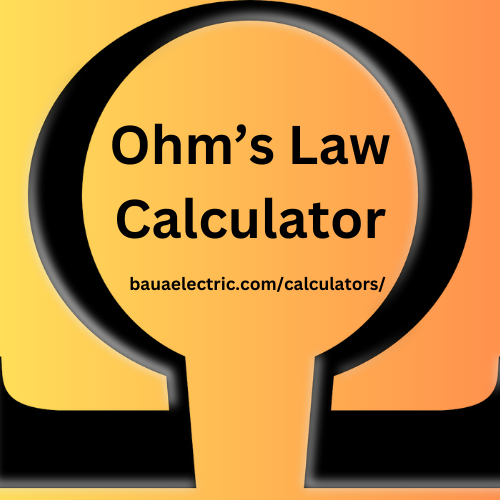Ohm’s Law Calculator
Calculated Values:
Voltage (V):
Current (I):
Resistance (R):
Power (P):
Understanding Ohm’s Law: The Foundation of Electrical Circuits
When diving into the world of electricity, you might come across the term Ohm’s Law. Whether you’re a student of physics, an aspiring electrician, or just curious about how electrical circuits work, understanding Ohm’s Law is key to unlocking many of the mysteries of electricity. Let’s break it down in simple, human language!
What is Ohm’s Law?
Ohm’s Law is a fundamental principle in electrical engineering and physics that describes the relationship between voltage, current, and resistance in an electrical circuit. It’s named after Georg Simon Ohm, a German physicist who discovered this relationship in the 1820s.
The law states that: V=I×RV = I \times R
Where:
- V is the voltage (in volts, V),
- I is the current (in amperes, A), and
- R is the resistance (in ohms, Ω).
In simple terms, Ohm’s Law tells us how the voltage (the electrical pressure) needed to push a current through a resistor (which limits the flow of electricity) is related to the amount of current that flows and the resistance in the circuit.
Breaking Down the Formula
- Voltage (V): This is the force or pressure that pushes the electric current through the circuit. It’s like the water pressure in a pipe that forces water to flow.
- Current (I): This is the flow of electric charge. If voltage is the “pressure,” then current is the “flow” of electrons through the wires. It’s measured in amperes (amps, A).
- Resistance (R): This is the opposition to the flow of current in the circuit. It’s similar to how the width of a pipe affects the flow of water. The narrower the pipe (or the higher the resistance), the harder it is for electricity to flow.
Real-World Example: How Does Ohm’s Law Apply?
Imagine you’re setting up a simple electrical circuit with a battery, a lightbulb, and a wire. The battery provides the voltage (V), the wire carries the current (I), and the lightbulb adds resistance (R). By applying Ohm’s Law, you can determine how much current will flow for a given voltage and resistance.
For example, let’s say you have a 12V battery and a resistor with a resistance of 6 ohms. Using Ohm’s Law: I=VR=12V6Ω=2AI = \frac{V}{R} = \frac{12V}{6Ω} = 2A
This means that 2 amps of current will flow through the circuit. By using this simple formula, you can calculate the current, voltage, or resistance of any electrical circuit, as long as you know the other two values!
Applications of Ohm’s Law
Ohm’s Law is essential for various practical applications in everyday life and electronics. Here are a few areas where it’s commonly used:
- Circuit Design: Engineers and electricians use Ohm’s Law to design safe and efficient electrical circuits. It helps them select the correct resistors and ensure that the current doesn’t exceed safe limits.
- Power Supply Units: When designing devices like power supply units (PSUs) or chargers, Ohm’s Law helps determine the correct voltage and current needed to power electronic gadgets.
- Electric Heating: Ohm’s Law plays a crucial role in electric heaters, where resistance in a wire causes the flow of current to generate heat.
- Troubleshooting Circuits: If a circuit is malfunctioning, understanding Ohm’s Law allows technicians to troubleshoot issues like short circuits, too high or low current, and improper voltage.
Why Is Ohm’s Law Important?
Ohm’s Law is the bedrock of understanding how electricity behaves in a circuit. Without it, designing safe and reliable electrical devices would be nearly impossible. The beauty of Ohm’s Law is its simplicity — just a few variables (voltage, current, and resistance) determine how an electrical circuit behaves.
Ohm’s Law in Everyday Devices
Every electronic device, from your smartphone to household appliances, relies on Ohm’s Law to function correctly. By knowing the voltage, current, and resistance of various components, engineers can design devices that work efficiently and safely.
Conclusion
Ohm’s Law might sound like a complex scientific principle, but it’s incredibly practical and easy to understand once broken down. Whether you’re building your own circuits, working in electronics, or simply trying to understand the devices around you, Ohm’s Law gives you the power to calculate and understand the behavior of electrical circuits.
Now that you know how Ohm’s Law works, you can start applying it to various electrical projects or even use it in your daily life to troubleshoot your electronic devices. Keep in mind that this law is the foundation of electrical engineering, and mastering it will help you with much more advanced concepts in the world of electricity and electronics!
Also Check Other calculators
- Resistor Color Code Calculator
- Voltage Drop Calculator
- Power Consumption Calculator
- Cable Size Calculator
- Electrical Power Loss Calculator (AC & DC)
- capacitor calculator for required power factor
- kWh to Ah | kiloWatt hour to Amps-hour calculator
- Watts to kWh to Watts conversion calculator
- Power factor calculator and correction capacitor
- Kilowatt (kW) to horsepower (hp) conversion calculator

